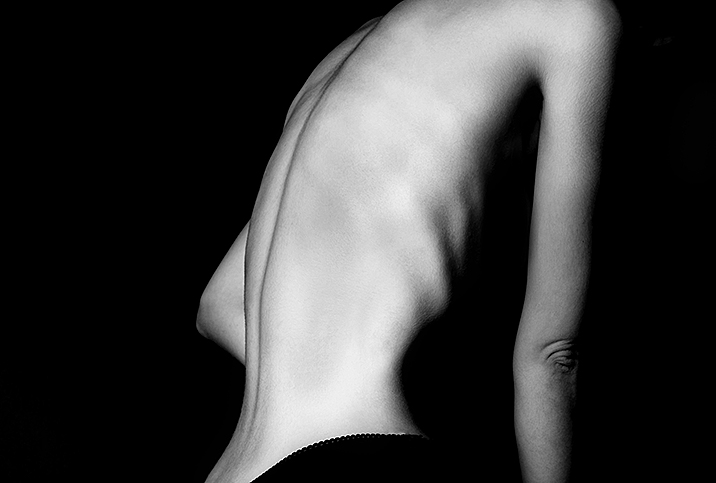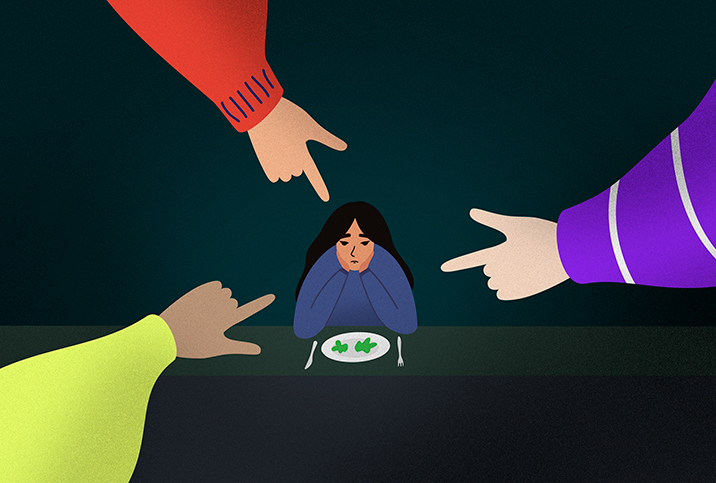What Exactly Is Anorexia?

Anorexia nervosa (AN) comes via the Greek an-, without, and orexis, appetite. Of course, as we know, this doesn't necessarily mean a person with the disorder has no appetite. In fact, the etymology can't begin to spell out exactly what AN really is, and how it can affect people's relationships in all its varied forms.
"Despite the fact that we have been studying and treating eating disorders for decades, the stereotype is still that anorexia affects young, cis-gendered, white, fairly affluent women," said Christine Peat, Ph.D., a clinical associate professor in the Center of Excellence for Eating Disorders at the University of North Carolina–Chapel Hill.
Mainstream understandings of the disorder can also get in the way of more helpful, nuanced understanding.
"If it were as simple as being exposed to a really toxic culture, then we all would have an eating disorder," Peat added.
Specific criteria that can affect many bodies
To be officially diagnosed with AN, someone must meet all of the current criteria in the Diagnostic and Statistical Manual of Mental Disorders (DSM-5):
- Restriction of food intake leading to weight loss or a failure to gain weight, resulting in a "significantly low body weight" of what would be expected for someone's age, sex and height (BMI < 18.5).
- Fear of becoming fat or gaining weight.
- A distorted view of themselves and of their condition, as in thinking they are overweight when they are actually underweight or believing that they will gain weight from eating a single meal.
Critically, to have anorexia, you have to experience your body differently from how the world perceives you. One way to test this could be by using body image scales. When asked what image reflects their current body size, people with AN consistently point to a body larger than theirs, indicating body image distortion. Yet, when asked what image reflects the body size of another person, they show no discrepancy between perception and reality.
These criteria help clinicians identify people in need of treatment. However, such criteria have come under criticism in recent years by advocates who push to recognize that anorexia nervosa can happen at any size, regardless of body mass index (BMI). For example, a 2019 study indicated people with larger bodies (BMI >18.5), but who had other symptoms of AN, are as likely as underweight patients to deal with physical and psychological complications. Still, because of DSM-5 criteria, these individuals are instead diagnosed with "atypical" anorexia nervosa, since they do not meet the underweight criteria.
'The reality is that eating disorders don't discriminate. Anyone can struggle with an eating disorder.'
"It's tough because, from a research perspective, there are certain parameters that we have to use to measure things," Peat said, referencing such parameters as being underweight by BMI. But that doesn't have to invalidate any one person's struggles with AN; it doesn't mean you don't have something worth discussing or seeking treatment for.
"The reality is that eating disorders don't discriminate. Anyone can struggle with an eating disorder," Peat continued, noting the condition can occur irrespective of race, gender, sexual orientation and socioeconomic class. "The media continues to use the same sorts of images over and over again."
To portray anorexia nervosa, the media and the field of psychology have repeatedly relied on images of emaciated white girls and women to get the idea across. But not all cases of AN or atypical AN are the same.
"One of the other common misperceptions is that to have anorexia nervosa, you basically have to be at death's door or be so emaciated that you can't function," Peat said. In reality, any one of the students or faculty walking around her UNC campus could be engaging with dietary restrictions in ways that can be life-threatening or have intrusive and distorted thoughts about food, calories and their bodies on a regular basis.
"The more that we have the Dr. Phils of the world, interviewing these people who basically look the same and have the same presentation, the more we do a disservice to people with eating disorders because it reinforces the idea that this is how you have to look in order to have an eating disorder," Peat explained.
AN has more than one narrative
In addition to affecting more than one type of body, anorexia nervosa happens for more than one reason. A popular narrative is that people with AN strive for "perfectionism" and "control" in a society—like the U.S.—that emphasizes strict body ideals. Of course, although this is true of many—and there's research to back it up—it's not the only story.
The control and perfectionism issues, Peat noted, have been talked about a lot.
"But I also think that it's a little bit reductionistic," she added.
That's because, as with many disorders, anorexia nervosa is influenced by a powerful and complex mix of biological, psychological and social factors.
"First and foremost, we know that anorexia nervosa and all eating disorders really are biologically based disorders," Peat said. "The reality is that some have the genetic predisposition to develop an eating disorder. And then from there, there are a whole host of other kinds of psychological and environmental factors that might play a role in the development of anorexia nervosa."
As with many disorders, anorexia nervosa is influenced by a powerful and complex mix of biological, psychological and social factors.
Peat is also director of the National Center of Excellence for Eating Disorders, a position that allows her to hear many widely varying stories about people's eating and body image issues.
"Many don't necessarily talk about wanting to have control or wanting to be perfect," Peat said. "They do have significant depression or anxiety that may have tipped those genetic scales and the balance of developing an eating disorder."
Depression and anxiety result from issues with emotion regulation. We all need to regulate emotions in a healthy way, which can be hanging out with friends, playing music or spending time in nature. But people with AN might self-regulate by not eating or excessively working out.
"Many who go on to develop eating disorders also struggle with emotion regulation," Peat said. "Your relationship with food and body may be one way to manage some of those really distressing or really tough emotions."
The risks of food insecurity
Another lesser-known story has to do with food insecurity.
"There's been some growing research that food insecurity is actually a risk factor for the development of eating disorders," Peat said. "I've done clinical interviews and spoken with patients who have talked about their history of food insecurity as almost sort of setting them up for an eating disorder."
For example, some have told Peat about their experiences with food stamps or SNAP benefits available in the home at the beginning of the month, but that ran out by the end. This, in their eyes, set them up on a binging/restricting pattern, which is a subtype of AN and characterizes other disorders, such as bulimia nervosa and binge eating disorder.
"In addition to setting up a binge/restrict pattern, food insecurity sets them up to almost not pay attention to their own hunger and satiety cues," Peat said.
The trouble with feeling natural hunger and fullness cues in the body has been identified as a risk factor and/or result of disordered eating.
"We haven't really found, sort of, the 'silver bullet' in terms of what exactly makes people vulnerable to an eating disorder," Peat explained. "But representing AN in more diverse ways might help deepen understanding and encourage more people to seek information and help."
Reframing anorexia and healthy eating
Just as anorexia nervosa and other eating disorders can present in many forms, seeking help does not require a specific BMI or narrative.
"I think for anyone who is struggling with food and their body, any of those sorts of things, it's worth talking to a specialist," Peat said.
Her rule of thumb is that if you feel unhappy in your relationship with your body or food, or if recurrent and intrusive thoughts about them interfere with your concentration, job and/or social life, that's a warning flag.
"You shouldn't have to feel like you have to wait until things really go off the rails to seek help," Peat advised.
However, Peat understands that seeking help can be challenging and inaccessible. If your insurance doesn't cover treatment, or if you're not sure you're ready to see a professional, free and low-cost resources can help equip you with more support and information.
Even reading articles like these can spark thoughts and conversations that change our way of thinking about topics we think we understand, like AN and healthy eating.
"There are some days where you might eat all the cookies and others where you leave several on the plate," Peat said. "'Normal' eating is defined by flexibility. That there isn't this rigidity around, 'I can only eat after certain hours. I'm not supposed to eat X number of carbs.'"
Treating anorexia nervosa, eating disorders and anything along the spectrum of disordered eating, Peat noted, isn't just about the number on the scale. "The motivation is getting back to a life that you find worthwhile and meaningful. Food becomes a part of that equation, but it doesn't dominate everything."


















